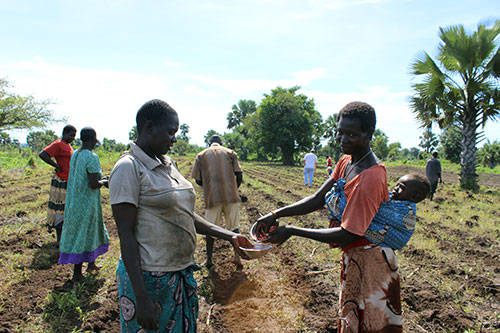
Northern Uganda was the epicenter of a decades-long insurgency by the Lord’s Resistance Army that killed 100,000 people and displaced an estimated 2 million. The conflict still clouds memories here, but a more pressing concern—climate change—is jeopardizing cropland and upending the way smallholder farmers plant, cultivate and harvest crops.
Two years ago, Leo Odongo was a subsistence farmer eking out an existence in northern Uganda’s war-torn Kole District. A typical smallholder farmer, he grew traditional crops such as millet and cassava on one acre of land, while battling erratic rainfall and lingering droughts.
Then an international development project implemented by NCBA CLUSA and funded by the U.S. Department of Agriculture brought conservation agriculture training to his region. Today, he’s earning enough profit to educate his children, cover family medical expenses and invest in improved seed varieties and conservation farming equipment.
Odongo learned how to construct a grid of planting basins on his land during the dry season. The grid pattern varies depending on rainfall patterns and soil type, but the method consistently delivers concentrated fertilizer and water directly to crop roots, while disturbing as little soil as possible.
The technique helps restore fertility to soil depreciated during years of excessive plowing or chemical fertilization. The conservation farming principles of minimum soil disturbance, soil rotation and mulching are helping smallholder farmers turn better yields.
During his second season of conservation farming, Odongo harvested close to 4,000 lbs (1,800 kg) of maize and 3,300 lbs (1,500 kg) of beans, earning a total of US$872 (UGX2,268,000) and turning a profit of $600. Previously, his harvest barely fed his family.
The profit allows Odongo to not only pay for his family’s education and medical expenses, but also to save money. He has plans to lease more land for conservation farming and buy a conservation farming ripper and oxen.

With his newfound skills, Odongo is now a leader in the community, helping other farmers adopt climate-smart agricultural methods.
“[The] USDA has given me the privilege to train fellow farmers—especially the women of Oyima Farmer’s Association—in conservation farming techniques to boost family incomes,” he said.
One such woman is Nyangoma Sayuni, a single mother uncertain she could provide basic needs for her eight children before learning conservation farming techniques at a local cooperative.
Using traditional farming methods, Sayuni had for years cultivated two acres of land. She never turned a profit. After a neighbor invited her to a community meeting at Mukama Asiimwe Cooperative in Uganda’s Masindi District, Sayuni and 29 other smallholder farmers—16 of whom are women—started training in conservation farming led by an NCBA CLUSA field team.
At first skeptical, Sayuni implemented conservation farming on only half of her land. But at harvest, she discovered that her labor costs dropped by 50 percent, while her maize yield doubled, weighing in at nearly 4,000 lbs (1800 kg).
“Nine of the 16 women adopted the practice after witnessing the significant increase in my yields,” Sayuni said.
She invested her earnings by leasing more land and purchasing inputs for the next growing season. Her profit of US$445 (UGX1,128,075) from the sale of more than 7,800 lbs (3,560 kg) of maize allowed her to enroll her children in school, open a merchandise shop and even buy a motorcycle to start a taxi side business.
“Conservation farming turned my tears to joy,” Sayuni said. “I do not live in uncertainty like before. The yields from conservation farming feed my children.”
Sayuni now coaches other smallholder farmers in conservation agriculture at Mukama Asiimwe Cooperative. Together, co-op members have created a local credit union that allows them to save and borrow money to further their conservation farming methods.


